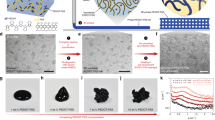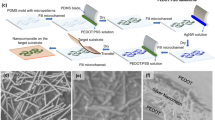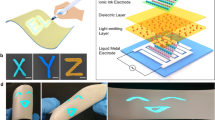Abstract
Three-dimensional printing could be used to create complex and multifunctional soft electronic devices. However, printing solid-state elastic conductors with three-dimensional geometries is challenging because the rheological properties of existing inks typically only allow for layer-wise deposition. Here we show that an emulsion system—consisting of a conductive elastomer composite, immiscible solvent and emulsifying solvent—can be used for the omnidirectional printing of elastic conductors. The viscoelastic properties of the composite provide structural integrity to the printed features—allowing freestanding, filamentary and out-of-plane three-dimensional geometries to be directly written—and pseudo-plastic and lubrication behaviours that provide printing stability and prevent nozzle clogging. Printed structures of the intrinsically stretchable conductor exhibit a minimum feature size less than 100 μm and stretchability of more than 150%. The vapourisation of the dispersed solvent phase in the emulsion results in the formation of microstructured, surface-localized conductive networks, which improve the electrical conductivity. To illustrate the capabilities of our approach, we create a skin-mountable temperature sensor with a matrix-type stretchable display based on omnidirectionally printed elastic interconnects.
This is a preview of subscription content, access via your institution
Access options
Access Nature and 54 other Nature Portfolio journals
Get Nature+, our best-value online-access subscription
$29.99 / 30 days
cancel any time
Subscribe to this journal
Receive 12 digital issues and online access to articles
$119.00 per year
only $9.92 per issue
Buy this article
- Purchase on Springer Link
- Instant access to full article PDF
Prices may be subject to local taxes which are calculated during checkout






Similar content being viewed by others
Data availability
The data that support the findings of this study are available from the corresponding authors upon reasonable request.
References
Wang, S. et al. Skin electronics from scalable fabrication of an intrinsically stretchable transistor array. Nature 555, 83–88 (2018).
Ma, Z. et al. Permeable superelastic liquid-metal fibre mat enables biocompatible and monolithic stretchable electronics. Nat. Mater. 20, 859–868 (2021).
Jung, D. et al. Highly conductive and elastic nanomembrane for skin electronics. Science 1026, 1022–1026 (2021).
Liu, S., Shah, D. S. & Kramer-Bottiglio, R. Highly stretchable multilayer electronic circuits using biphasic gallium-indium. Nat. Mater. 20, 851–858 (2021).
Lv, G. et al. Flexible, conformable organic semiconductor proximity sensor array for electronic skin. Adv. Mater. Interfaces 7, 2000306 (2020).
Sempionatto, J. R. et al. An epidermal patch for the simultaneous monitoring of haemodynamic and metabolic biomarkers. Nat. Biomed. Eng. 5, 737–748 (2021).
Qi, D. et al. Highly stretchable gold nanobelts with sinusoidal structures for recording electrocorticograms. Adv. Mater. 27, 3145–3151 (2015).
Xu, L. et al. 3D multifunctional integumentary membranes for spatiotemporal cardiac measurements and stimulation across the entire epicardium. Nat. Commun. 5, 3329 (2014).
Markvicka, E. et al. ElectroDermis: fully untethered, stretchable, and highly-customizable electronic bandages. In Proc. 2019 CHI Conference on Human Factors in Computing Systems 632 (ACM, 2019).
Yoon, J. et al. Soft modular electronic blocks (SMEBs): a strategy for tailored wearable health-monitoring systems. Adv. Sci. 6, 1801682 (2019).
Ahn, B. Y. et al. Omnidirectional printing of flexible, stretchable, and spanning silver microelectrodes. Science 323, 1590–1593 (2009).
Zhang, B. et al. One-step sub-micrometer-scale electrohydrodynamic inkjet three-dimensional printing technique with spontaneous nanoscale Joule heating. ACS Appl. Mater. Interfaces 9, 29965–29972 (2017).
Zhou, N., Liu, C., Lewis, J. A. & Ham, D. Gigahertz electromagnetic structures via direct ink writing for radio‐frequency oscillator and transmitter applications. Adv. Mater. 29, 1605198 (2017).
Liashenko, I., Rosell-Llompart, J. & Cabot, A. Ultrafast 3D printing with submicrometer features using electrostatic jet deflection. Nat. Commun. 11, 753 (2020).
Kim, F. et al. Direct ink writing of three-dimensional thermoelectric microarchitectures. Nat. Electron. 4, 579–587 (2021).
Ladd, C., So, J. H., Muth, J. & Dickey, M. D. 3D printing of free standing liquid metal microstructures. Adv. Mater. 25, 5081–5085 (2013).
Gannarapu, A. & Gozen, B. A. Freeze-printing of liquid metal alloys for manufacturing of 3D, conductive, and flexible networks. Adv. Mater. Technol. 1, 1600047 (2016).
Wang, Y. et al. Printable liquid-metal@PDMS stretchable heater with high stretchability and dynamic stability for wearable thermotherapy. Adv. Mater. Technol. 4, 1800435 (2019).
Park, Y.-G., An, H. S., Kim, J.-Y. & Park, J.-U. High-resolution, reconfigurable printing of liquid metals with three-dimensional structures. Sci. Adv. 5, eaaw2844 (2019).
Park, Y. G. et al. Three-dimensional, high-resolution printing of carbon nanotube/liquid metal composites with mechanical and electrical reinforcement. Nano Lett. 19, 4866–4872 (2019).
Glickman, E., Levenshtein, M., Budic, L. & Eliaz, N. Interaction of liquid and solid gallium with thin silver films: synchronized spreading and penetration. Acta Mater. 59, 914–926 (2011).
Oh, E. et al. Highly reliable liquid metal–solid metal contacts with a corrugated single-walled carbon nanotube diffusion barrier for stretchable electronics. Adv. Funct. Mater. 28, 1806014 (2018).
Kramer, R. K., Boley, J. W., Stone, H. A., Weaver, J. C. & Wood, R. J. Effect of microtextured surface topography on the wetting behavior of eutectic gallium-indium alloys. Langmuir 30, 533–539 (2014).
Mohammed, M., Sundaresan, R. & Dickey, M. D. Self-running liquid metal drops that delaminate metal films at record velocities. ACS Appl. Mater. Interfaces 7, 23163–23171 (2015).
Park, M. et al. Highly stretchable electric circuits from a composite material of silver nanoparticles and elastomeric fibres. Nat. Nanotechnol. 7, 803–809 (2012).
Sasaki, M. et al. Highly conductive stretchable and biocompatible electrode–hydrogel hybrids for advanced tissue engineering. Adv. Healthcare Mater. 3, 1919–1927 (2014).
Chae, C. et al. 3D-stacked carbon composites employing networked electrical intra-pathways for direct-printable, extremely stretchable conductors. ACS Appl. Mater. Interfaces 7, 4109–4117 (2015).
Matsuhisa, N. et al. Printable elastic conductors with a high conductivity for electronic textile applications. Nat. Commun. 6, 7461 (2015).
Matsuhisa, N. et al. Printable elastic conductors by in situ formation of silver nanoparticles from silver flakes. Nat. Mater. 16, 834–840 (2017).
Kim, S. W., Kwon, S. N. & Na, S. I. Stretchable and electrically conductive polyurethane-silver/graphene composite fibers prepared by wet-spinning process. Compos. B Eng. 167, 573–581 (2019).
Tehrani, F. et al. Laser-induced graphene composites for printed, stretchable, and wearable electronics. Adv. Mater. Technol. 4, 1900162 (2019).
Valentine, A. D. et al. Hybrid 3D printing of soft electronics. Adv. Mater. 29, 1703817 (2017).
Kim, J. Y. et al. 3D printable composite dough for stretchable, ultrasensitive and body-patchable strain sensors. Nanoscale 9, 11035–11046 (2017).
Guo, S.-Z., Qiu, K., Meng, F., Park, S. H. & McAlpine, M. C. 3D printed stretchable tactile sensors. Adv. Mater. 29, 1701218 (2017).
Wu, Q., Zou, S., Gosselin, F. P., Therriault, D. & Heuzey, M. C. 3D printing of a self-healing nanocomposite for stretchable sensors. J. Mater. Chem. C 6, 12180–12186 (2018).
Parida, K. et al. Extremely stretchable and self-healing conductor based on thermoplastic elastomer for all-three-dimensional printed triboelectric nanogenerator. Nat. Commun. 10, 2158 (2019).
Lee, H. S. et al. Three-dimensionally printed stretchable conductors from surfactant-mediated composite pastes. ACS Appl. Mater. Interfaces 11, 12622–12631 (2019).
Hwang, Y. et al. Lubricant-added conductive composite for direct writing of a stretchable electrode. ACS Appl. Mater. Interfaces 11, 48459–48465 (2019).
Yoon, I. S. et al. 3D printing of self‐wiring conductive ink with high stretchability and stackability for customized wearable devices. Adv. Mater. Technol. 4, 1900363 (2019).
Wu, W. et al. Synergistic combination of carbon-black and graphene for 3D printable stretchable conductors. Mater. Technol. 37, 1971–1980 (2022).
Kang, Y. et al. High-resolution printable and elastomeric conductors from strain-adaptive assemblies of metallic nanoparticles with low aspect ratios. Small 16, 2004793 (2020).
Princen, H. M. & Kiss, A. D. Osmotic pressure of foams and highly concentrated emulsions. 2. Determination from the variation in volume fraction with height in an equilibrated column. Langmuir 3, 36–41 (1987).
Mason, T. G., Bibette, J. & Weitz, D. A. Elasticity of compressed emulsions. Phys. Rev. Lett. 75, 2051–2054 (1995).
Mason, T. G. et al. Osmotic pressure and viscoelastic shear moduli of concentrated emulsions. Phys. Rev. E 56, 3150–3166 (1997).
Balberg, I. & Binenbaum, N. Computer study of the percolation threshold in a two-dimensional anisotropic system of conducting sticks. Phys. Rev. B 28, 3799–3812 (1983).
Nam, S. et al. Effects of silica particles on the electrical percolation threshold and thermomechanical properties of epoxy/silver nanocomposites. Appl. Phys. Lett. 99, 043104 (2011).
Ko, Y. et al. Stretchable conductive adhesives with superior electrical stability as printable interconnects in washable textile electronics. ACS Appl. Mater. Interfaces 11, 37043–37050 (2019).
Byun, J. et al. Fully printable, strain-engineered electronic wrap for customizable soft electronics. Sci. Rep. 7, 45328 (2017).
Byun, J. et al. A single droplet‐printed double‐side universal soft electronic platform for highly integrated stretchable hybrid electronics. Adv. Funct. Mater. 27, 1701912 (2017).
Acknowledgements
This work was supported by the Nano & Material Technology Development Program through the National Research Foundation of Korea (NRF) funded by the Ministry of Science and ICT (NRF-2020M3D1A2101799), the Korea Institute of Science and Technology (KIST) Future Resource Research Program (grant no. 2E32501) and KU-KIST School Project. B.L. also appreciates support from the NRF grant funded by the Korea government (MSIT) (no. 2021R1C1C2091957).
Author information
Authors and Affiliations
Contributions
B.L., H.C., S.M. and S.C. conceived the idea. B.L. and S.C. designed the materials and experiments. B.L., H.C. and S.M. fabricated and characterized the printable inks and elastic conductors. Y.K., Y.-S.R. and H.K. assisted with the materials design and characterization. B.L. carried out the FEA in discussion with S.C. B.L. and H.C. designed and fabricated the skin-mountable devices. B.L., H.C. and S.C. wrote the manuscript with input from all the authors. H.K. and J.J. reviewed and revised the manuscript. All the authors discussed the results and approved the manuscript.
Corresponding authors
Ethics declarations
Competing interests
The authors declare no competing interests.
Peer review
Peer review information
Nature Electronics thanks Lixue Tang, Hyunwoo Yuk and Nanjia Zhou for their contribution to the peer review of this work.
Additional information
Publisher’s note Springer Nature remains neutral with regard to jurisdictional claims in published maps and institutional affiliations.
Supplementary information
Supplementary Information
Supplementary Figs. 1–27, Tables 1 and 2 and references.
Supplementary Video 1
Three-dimensional spiral structure printed with emulsion-based ink.
Supplementary Video 2
Elasticity of omnidirectionally printed self-supporting conductors.
Supplementary Video 3
Single-step writing of self-supporting and out-of-plane geometries.
Supplementary Video 4
On-skin temperature visualization system based on omnidirectionally printed elastic conductors.
Rights and permissions
Springer Nature or its licensor (e.g. a society or other partner) holds exclusive rights to this article under a publishing agreement with the author(s) or other rightsholder(s); author self-archiving of the accepted manuscript version of this article is solely governed by the terms of such publishing agreement and applicable law.
About this article
Cite this article
Lee, B., Cho, H., Moon, S. et al. Omnidirectional printing of elastic conductors for three-dimensional stretchable electronics. Nat Electron 6, 307–318 (2023). https://doi.org/10.1038/s41928-023-00949-5
Received:
Accepted:
Published:
Issue Date:
DOI: https://doi.org/10.1038/s41928-023-00949-5
This article is cited by
-
Full integration of highly stretchable inorganic transistors and circuits within molecular-tailored elastic substrates on a large scale
Nature Communications (2024)
-
Wearable and Implantable Light-Emitting Diodes and Their Biomedical Applications
Korean Journal of Chemical Engineering (2024)
-
Omnidirectional printing of stretchable electronics
Nature Electronics (2023)
-
Printed sustainable elastomeric conductor for soft electronics
Nature Communications (2023)



